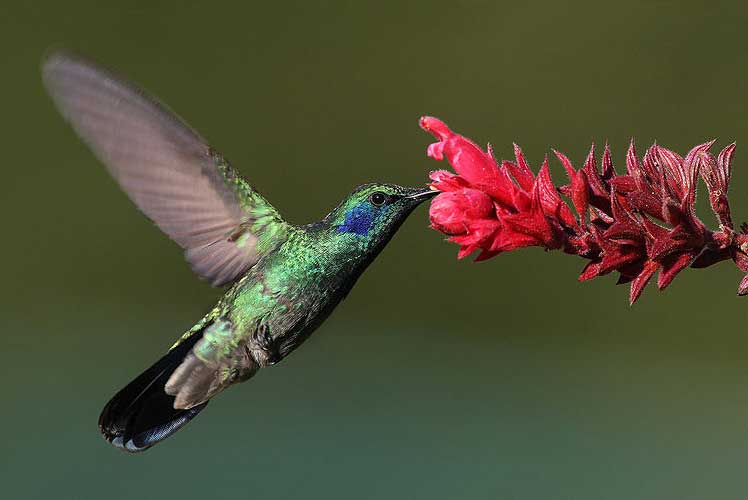Cladus: Eukaryota
Supergroup: Opisthokonta
Regnum: Animalia
Subregnum: Eumetazoa
Cladus: Bilateria
Cladus: Nephrozoa
Cladus: Deuterostomia
Phylum: Chordata
Subphylum: Vertebrata
Infraphylum: Gnathostomata
Superclassis: Tetrapoda
Classis: Aves
Subclassis: Carinatae
Infraclassis: Neornithes
Parvclassis: Neognathae
Ordo: Trochiliformes
Familia: Trochilidae
Subfamilia: Trochilinae
Genus: Colibri
Species: Colibri thalassinus
Subspecies: C. t. cabanidis - C. t. crissalis - C. t. cyanotus - C. t. kerdeli - C. t. thalassinus
Name
Colibri thalassinus (Swainson, 1827)
Reference
* Philos.Mag.n.s. 1 p.441
* Colibri thalassinus Report on ITIS
Vernacular names
English: Green Violet-ear
Español: Colibrí Verdemar, Colibrí oreja violeta
Français: Colibri thalassin
Nederlands: Groene violetoorkolibrie
日本語: ミドリハチドリ
Português: beija-flor-marrom-de-orelha-azul
中文: 綠紫耳蜂鳥
---------
The Green Violetear (Colibri thalassinus) is an attractive hummingbird that is a resident breeder in highlands from south-central Mexico, (the Trans-Mexican Volcanic Belt), to western Panama and in the Andes from northern Venezuela to Bolivia. It shows seasonal movements and wanders to the United States and even Canada.
The male Green Violetear is grass green above and becomes a bronze color on the rump and uppertail coverlets and is 11 — 11.5 cm (4.25 — 4.5 in) in length.[2] The tail is square and slightly notched with a broad dark blue subterminal band.[2] The northern nominate subspecies has a large violet central breast spot on the upper breast and a violet-blue band along the chin that often connects to the violet-blue "ear", giving the bird its name.[2] The female is similar to the male, but averages smaller and slightly duller, with a narrower violet band on the chin.[2] The remaining subspecies (from Costa Rica and southwards) lack the violet breast spot and chin, but retain the violet-blue "ear". The juvenile is a much duller version of the adult. Its plumage is generally olive green overall with dull gray wash to the underparts. The violet breast spot is either indistinct, incomplete, or absent.[2] A molting juvenile may show bright metallic color in patches, particularly on the throat or breast.[2]
The habitat is semi-open upland country with trees and scrubs. In South America, it generally prefers more humid habitats (e.g. edge of cloud forest) than the similar Sparkling Violetear, but the two can sometimes be seen together. The nest is a substantial cup of plant material 1-3m high in a tree, into which two white eggs are laid.
The Green Violetear's song is a vigorous CHEEP-chut-chut, chip CHEET which is repeated interminably through the day. The call a dry chut. These birds visit flowers of many species of herbs, trees and scrubs for nectar.
References
1. ^ BirdLife International (2004). Colibri thalassinus. 2006. IUCN Red List of Threatened Species. IUCN 2006. www.iucnredlist.org. Retrieved on 11 May 2006. Database entry includes justification for why this species is of least concern
2. ^ a b c d e f Williamson, Sheri L. (2001). Hummingbird of North America. New York: Houghton Mifflin Company. ISBN 0618024964.
* Hilty, Steven L. (2003): Birds of Venezuela. Christopher Helm, London. ISBN 0-7136-6418-5
* Stiles, F. Gary & Skutch, Alexander Frank (1989): A guide to the birds of Costa Rica. Comistock, Ithaca. ISBN 0-8014-9600-4

